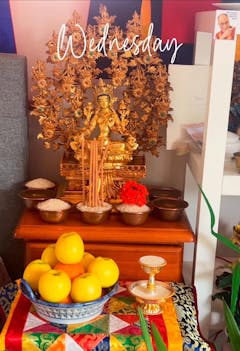Karmapa Statue: The Eighth Incarnation of the Buddha’s Activity
Karmapa statue is a powerful representation of the Karmapa, the head of the Kagyu lineage of Tibetan Buddhism. This meticulously crafted statue captures the essence of the 17th Karmapa, Ogyen Trinley Dorje, who is revered for his wisdom, compassion, and unwavering dedication to the teachings of the Buddha. The statue is made of copper and gold, with intricate detailing and semi-precious stones that reflect the sacredness of his lineage and his unique role as a spiritual leader.
This work of art is designed with great care, ensuring that every feature of the statue speaks to the Karmapa’s noble qualities. From his serene facial expression to his posture and robes, each detail is symbolically significant, offering a visual manifestation of the Karmapa’s deep commitment to the Dharma.
The Karmapa: The Embodiment of the Buddha's Activity
The Karmapa is one of the most important spiritual figures in Tibetan Buddhism, often regarded as the embodiment of the Buddha's active compassion. He is the head of the Kagyu school and is believed to be the reincarnation of a long line of spiritual teachers. The first Karmapa, Düsum Khyenpa, founded the lineage in the 12th century, and since then, each Karmapa has been recognized as the living manifestation of compassionate activity in the world.
Symbolism and Features of the Karmapa Statue
The Karmapa’s statue carries deep symbolism in both its appearance and meaning, reflecting his spiritual journey and role as a guide for all sentient beings:
- Posture: The Karmapa is often depicted seated in a relaxed yet dignified posture, symbolizing his equanimity and profound understanding of the nature of existence.
- Mudra: The Karmapa’s hand gestures (mudras) often depict the gesture of teaching or meditation, signifying his role as a guide and teacher of the Dharma.
- Robes: His robes are intricately designed, symbolizing his high spiritual status as a monk and spiritual leader. The color of his robes is often a reflection of the Kagyu tradition’s distinctive style and the lineage's deep commitment to the Dharma.
- Crown and Ornamentation: The Karmapa may also be depicted with a crown or other ornaments, signifying his esteemed position within the Tibetan Buddhist hierarchy. These adornments also reflect the wisdom and compassion he embodies.
- Lions and Lotus Seat: The Karmapa is often shown seated on a lion throne, which symbolizes fearlessness and the lion-like strength of the Dharma. The lotus seat beneath him represents purity and spiritual awakening.
The 17th Karmapa: A Modern Spiritual Leader
The current 17th Karmapa, Ogyen Trinley Dorje, is a modern and influential figure in Tibetan Buddhism. Born in Tibet in 1985, he was recognized as the 17th Karmapa at a young age. Known for his insightful teachings, his efforts in promoting environmental conservation, and his leadership in the modern world, the 17th Karmapa has become a guiding light for many followers of Tibetan Buddhism around the globe.
His teachings emphasize the importance of compassion, mindfulness, and the understanding of the nature of the mind. He has traveled widely, meeting with spiritual leaders, political figures, and practitioners to spread the message of peace and the importance of interfaith dialogue.
The Role of the Karmapa in Tibetan Buddhism
The Karmapa is not only a spiritual leader but also a teacher, healer, and protector of the Dharma. The Karmapa’s role extends beyond that of a religious figure—he is viewed as an active force for positive change in the world. His ability to lead with wisdom and compassion allows him to address both the individual needs of practitioners and the larger global issues facing humanity.
The Karmapa’s teachings on mind training (Lojong), meditation, and ethical conduct are considered essential practices for all practitioners, regardless of tradition. His leadership in guiding the Kagyu tradition ensures that the teachings of the Buddha continue to flourish.
A Symbol of Wisdom, Compassion, and Dharma
The Karmapa statue is not just an artistic rendering of a revered spiritual figure; it is a reminder of the profound wisdom, compassion, and spiritual activity that the Karmapa represents. Whether placed in a personal meditation space or in a larger temple, the Karmapa statue serves as an inspiration to cultivate inner peace, practice compassion, and strive toward enlightenment.
Through his legacy, teachings, and presence, the Karmapa embodies the ever-present activity of the Buddha, guiding us on the path of wisdom and compassion.
Mantra of the Karmapa
The Karmapa is associated with the following mantra:
Karmapa Chenno
This simple yet powerful mantra calls upon the Karmapa’s blessings, invoking his presence and guidance in times of need. It is a mantra of protection and spiritual advancement, reminding practitioners of the Karmapa’s compassionate activity in the world.






































































